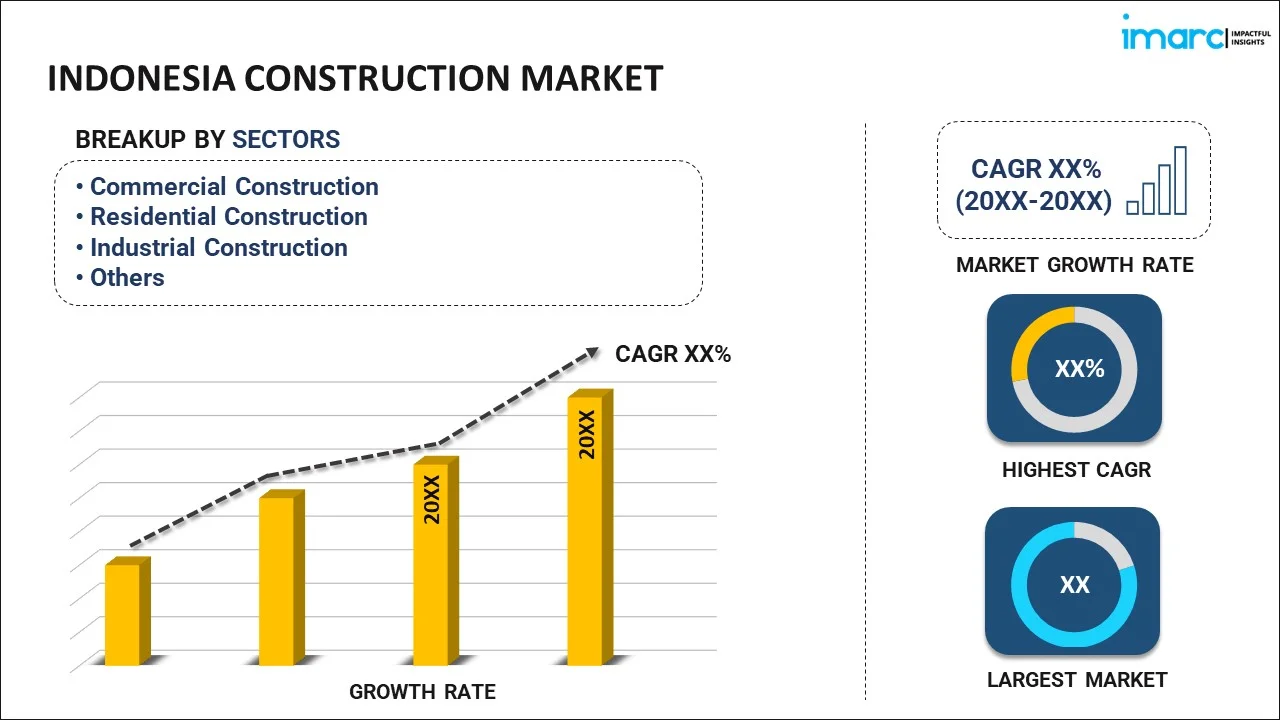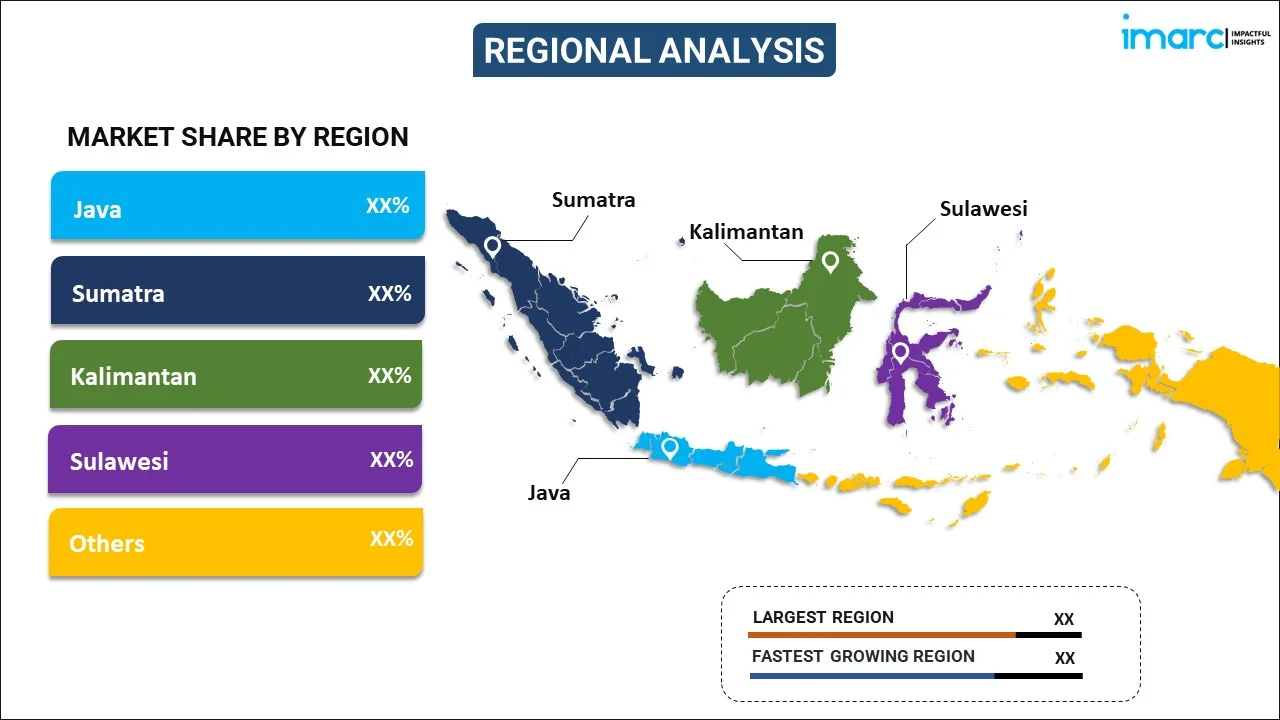
Indonesia Construction Market Report by Sector (Commercial Construction, Residential Construction, Industrial Construction, Infrastructure (Transportation) Construction, Energy and Utilities Construction), and Region 2024-2032
Market Overview:
Indonesia construction market size is projected to exhibit a growth rate (CAGR) of 6.84% during 2024-2032. The rapid urbanization and industrialization, the growing awareness and emphasis on sustainable construction, continuous technological advancements and innovations in construction chemicals, and rising focus on improving the overall quality and aesthetics of construction projects represent some of the key factors driving the market.
|
Report Attribute
|
Key Statistics
|
|---|---|
|
Base Year
|
2023 |
|
Forecast Years
|
2024-2032
|
|
Historical Years
|
2018-2023
|
| Market Growth Rate (2024-2032) | 6.84% |
Construction is the process of creating or building infrastructure or a facility, typically involving a combination of human labor, machinery, and materials. It encompasses a wide array of activities, from the initial planning and designing stages to the final execution and completion of a project. This intricate process involves several key components, such as site preparation, procurement of necessary materials, and the skilled coordination of various specialized trades. Construction projects can range from small-scale residential buildings to large-scale commercial structures, bridges, roads, and even intricate mega-projects. The construction industry plays a vital role in the development and growth of economies, as it provides employment opportunities and contributes significantly to the creation of essential physical assets and public infrastructure. With an emphasis on safety, quality, and adherence to building codes and regulations, the construction sector remains a cornerstone of modern society, shaping the physical environment we live and work in.
Indonesia Construction Market Trends:
The robust economic growth of Indonesia has a direct impact on the construction industry. As the economy expands, there is an increased demand for infrastructure, residential, and commercial developments. Additionally, rapid urbanization is a prominent driver. More Indonesians are moving to cities in search of better opportunities, which leads to a surge in construction projects, including housing, office spaces, and transportation infrastructure. Other than this, foreign direct investment (FDI) in construction projects is on the rise. The appeal of Indonesia to international investors and developers has boosted the construction sector. Besides this, the infrastructure of the nation requires significant improvement and expansion. Ports, airports, roads, and bridges are all in need of upgrades to support economic activities. In line with this, a growing population, particularly the middle class, drives the need for housing and commercial spaces. This demographic shift fuels construction activities. Furthermore, the expanding tourism industry of Indonesia is flourishing, and this has a direct impact on hospitality and leisure construction, including hotels and resorts. In line with this, the susceptibility of the nation to natural disasters, such as earthquakes and tsunamis, necessitates ongoing reconstruction efforts, further boosting construction activities. Apart from these factors, Indonesia is rich in natural resources, including minerals, coal, and palm oil. The extraction and processing of these resources require substantial infrastructure and facilities, contributing to construction demand. The export of these resources generates revenue that can be reinvested in construction projects. Furthermore, increasing awareness about environmental issues has led to the adoption of sustainable construction practices and green building standards, influencing project designs and materials used. Moreover, the adoption of modern construction technologies, such as Building Information Modeling (BIM) and automation, enhances efficiency and productivity in the industry.
Indonesia Construction Market Segmentation:
IMARC Group provides an analysis of the key trends in each segment of the market, along with forecasts at the country level for 2024-2032. Our report has categorized the market based on sector.
Sector Insights:

- Commercial Construction
- Residential Construction
- Industrial Construction
- Infrastructure (Transportation) Construction
- Energy and Utilities Construction
The report has provided a detailed breakup and analysis of the market based on the sector. This includes commercial construction, residential construction, industrial construction, infrastructure (transportation) construction, and energy and utilities construction.
Regional Insights:

- Java
- Sumatra
- Kalimantan
- Sulawesi
- Others
The report has also provided a comprehensive analysis of all the major regional markets, which include Java, Sumatra, Kalimantan, Sulawesi, and Others.
Competitive Landscape:
The market research report has also provided a comprehensive analysis of the competitive landscape in the market. Competitive analysis such as market structure, key player positioning, top winning strategies, competitive dashboard, and company evaluation quadrant has been covered in the report. Also, detailed profiles of all major companies have been provided.
Indonesia Construction Market Report Coverage:
| Report Features | Details |
|---|---|
| Base Year of the Analysis | 2023 |
| Historical Period | 2018-2023 |
| Forecast Period | 2024-2032 |
| Units | US$ Billion |
| Scope of the Report | Exploration of Historical and Forecast Trends, Industry Catalysts and Challenges, Segment-Wise Historical and Predictive Market Assessment:
|
| Sectors Covered | Commercial Construction, Residential Construction, Industrial Construction, Infrastructure (Transportation) Construction, Energy and Utilities Construction |
| Regions Covered | Java, Sumatra, Kalimantan, Sulawesi, Others |
| Customization Scope | 10% Free Customization |
| Report Price and Purchase Option | Single User License: US$ 3699 Five User License: US$ 4699 Corporate License: US$ 5699 |
| Post-Sale Analyst Support | 10-12 Weeks |
| Delivery Format | PDF and Excel through Email (We can also provide the editable version of the report in PPT/Word format on special request) |
Key Questions Answered in This Report:
- How has the Indonesia construction market performed so far and how will it perform in the coming years?
- What has been the impact of COVID-19 on the Indonesia construction market?
- What is the breakup of the Indonesia construction market on the basis of sector?
- What are the various stages in the value chain of the Indonesia construction market?
- What are the key driving factors and challenges in the Indonesia construction?
- What is the structure of the Indonesia construction market and who are the key players?
- What is the degree of competition in the Indonesia construction market?
Key Benefits for Stakeholders:
- IMARC’s industry report offers a comprehensive quantitative analysis of various market segments, historical and current market trends, market forecasts, and dynamics of the Indonesia construction market from 2018-2032.
- The research report provides the latest information on the market drivers, challenges, and opportunities in the Indonesia construction market.
- Porter's five forces analysis assist stakeholders in assessing the impact of new entrants, competitive rivalry, supplier power, buyer power, and the threat of substitution. It helps stakeholders to analyze the level of competition within the Indonesia construction industry and its attractiveness.
- Competitive landscape allows stakeholders to understand their competitive environment and provides an insight into the current positions of key players in the market.
Need more help?
- Speak to our experienced analysts for insights on the current market scenarios.
- Include additional segments and countries to customize the report as per your requirement.
- Gain an unparalleled competitive advantage in your domain by understanding how to utilize the report and positively impacting your operations and revenue.
- For further assistance, please connect with our analysts.
 Inquire Before Buying
Inquire Before Buying
 Speak to an Analyst
Speak to an Analyst
 Request Brochure
Request Brochure
 Request Customization
Request Customization




.webp)




.webp)












